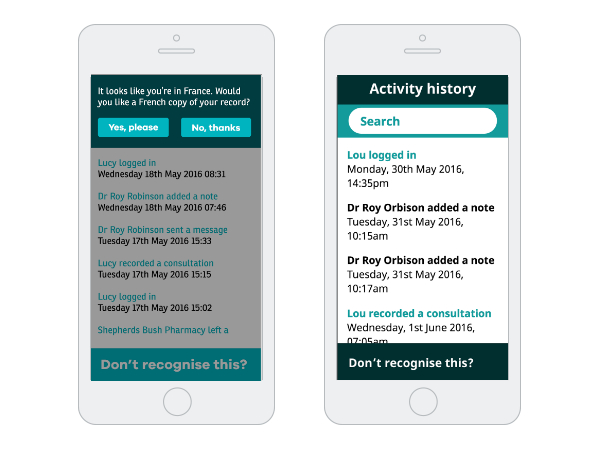How we worked
Following on from the service design, we started to prototype in browser. Rather than developing fully realised products, we were bringing complex moments of the experience to life by turning sketches into code so we could understand what information should be shown and how.


We tested what we made with an accessibility kit. But we also wanted to try technologies other than HTML, so we explored voice technology too, because for many of the furthest first users we are designing for, screens are inaccessible.
Our prototypes were a useful tool to support better conversations with patients and clinicians; they were also a great way to get ideas across quickly. They show how some of the most complex moments of the experience might work if a collaborative health information system existed.
What we did
Who I am
Patients at the end of life have to repeat a lot of information about themselves and their health. Sometimes this is a good thing, because it means patients can give accurate, up-to-date information about themselves and how they are feeling. But more often than not, we heard that repeating information was exhausting and upsetting because it made people feel like they were just an illness. So we demonstrated a way that patients can give information about themselves just once, and how that information could be displayed for the different members of their care or clinical teams.
Health information summaries
When a patient is first diagnosed with a new condition they have a lot of new information to take in. We heard from patients who came away from consultations not remembering or understanding what was said to them. In response to this, we prototypes a series of summaries that gave the patients and their carers the right data at the right time.

Summaries of complex care
As an older person's health deteriorates and becomes more complex, they have more information, appointments and things to remember. The experience map and insights from user research suggested that rather than seeing all that information, they need better, filtered information. We demonstrated this by taking the example of an appointment change. In this example, the patient telephones to change an appointment time. Simultaneously their daughter receives a notification to let them know of the change, along with other useful information like the best time to set off. The patient's schedule gets updated and we explored the idea of a screen or printouts on the fridge with summary information for the day.

Recording consultations
Patients often don't remember what was said to them during consultations. We prototyped how a consultation tool could be used to record conversations, with patient and clinician consent. Key information from the transcription can be highlighted to the patient and their care team.

Handovers
Handovers are an important point where having one dataset can help stop unnecessary duplication. The handover we decided to look into was transport staff at a hospice, providing drivers with information from the night before about where patients are for pickup and how they access the house.
Adding to the record
Access to health information cannot only be by text, because it's just not accessible enough. So we explored adding to the record not only by text but also voice.
Auto translate
English is not a first language for many clinicians and patients. We explored the idea of health data auto-translating into whatever language the individual felt most comfortable using. A leap forward would also be to offer health information that could be translated when someone went on holiday, which could help patients at the end of life feel capable of travelling and not stuck because of their illness.
Access and permissions
Consent and permission with health data is complex and an area where more work is needed. We prototypes how permissions could work with voice, giving patients the opportunity to phone up to find out who had last accessed their health information and why as a kind of transparency log.

Flagging when something's not right
Collaborating on health records between patients and clinicians is hard, particularly because of triage. But sometimes if something's changed it can be useful for the patient to flag it. So we explored this in a tool that helps patients record things that change, to bring up in their next consultation.

Who to call and when
Often a patient and their carers do not know who they should contact when something goes wrong. So we made a prototype that puts all the people involved in a patient's care in one place, with information about who to contact in what situation.

Explore our prototypes here.